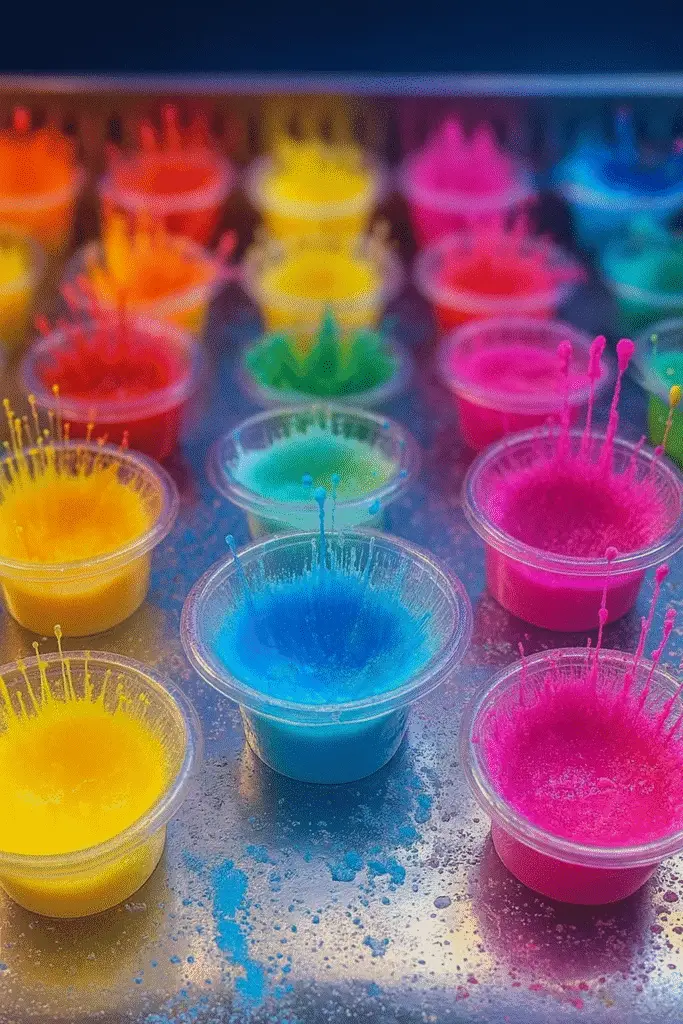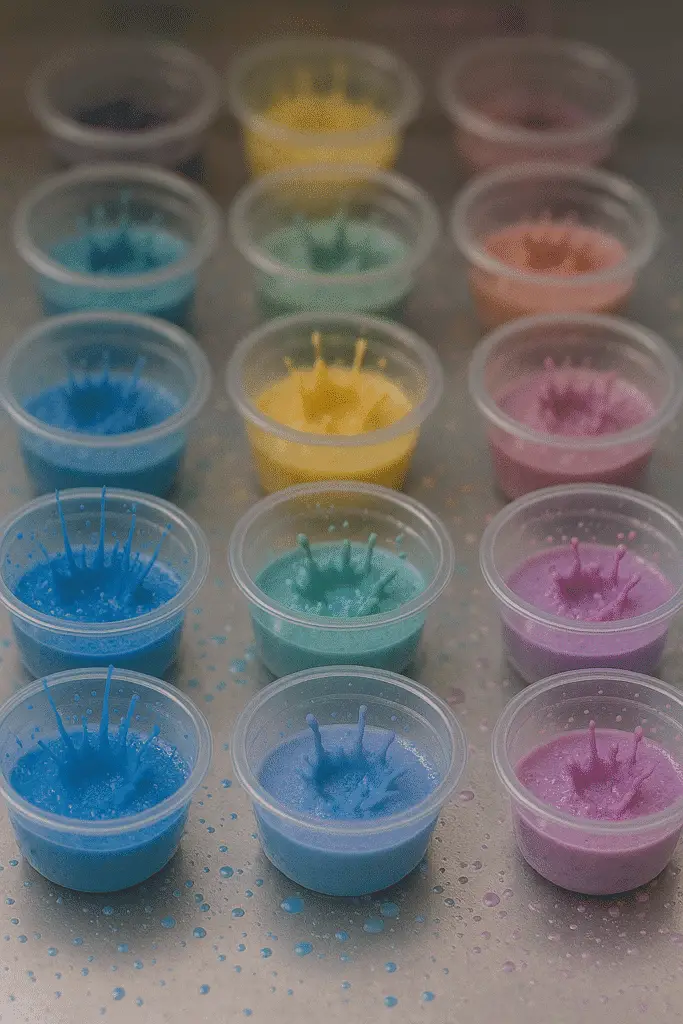Ever seen a science experiment make kids scream with joy and learn chemistry at the same time? These Baking Soda & Vinegar Fireworks are pure magic. With just a few pantry staples, you can create explosive color, fizz, and awe right at the kitchen table.
💥 Did you know vinegar + baking soda was used in 18th-century volcano demos? Today, we’re cranking that up with food coloring and a hands-on twist kids won’t forget. It’s messy, educational, and ridiculously fun.
So grab a muffin tin, your little lab assistants, and let’s turn science into art — one fizz at a time.

🧪 Materials You’ll Need for DIY Fireworks
I can’t even count how many times I’ve scrambled around the kitchen hunting for “science experiment stuff” five minutes before my kids lose their minds from boredom. This one? It’s blissfully simple. The materials for Baking Soda & Vinegar Fireworks are basic — like, “you probably already have them” basic.
The Staples You’ll Always Need
- Baking soda – Regular ol’ sodium bicarbonate. I use the giant Costco box. You’ll need about a tablespoon per cup or muffin tin section.
- White vinegar – Doesn’t need to be fancy. I just pour it into a kid-friendly measuring cup so they can do the pouring themselves (big win for independence!).
- Food coloring – The brighter the better! I let my kids pick their own colors, which sometimes means wild mixes like neon green and purple. Liquid works great, but gel makes the fizz pop even more.
- Small cups or muffin tins – Muffin tins are my go-to. They keep everything contained, and each section becomes its own mini explosion zone. I’ve also used egg cartons in a pinch.
- Tray or shallow pan – Trust me, this is your mess-saver. Even though it’s not a messy experiment per se, vinegar has a habit of creeping across your table like a villain in a movie.
Little Extras That Go a Long Way
- Droppers or spoons – Makes pouring the vinegar more controlled. And somehow more scientific for the kiddos.
- Paper towels – Optional, but nice for quick wipe-ups.
- Goggles – Okay, not required, but they make kids feel like real scientists. And that’s half the fun.
I used to avoid science crafts because they felt too chaotic or involved stuff I didn’t have. This one flips that. It’s low-prep, high-impact — especially when they see the foam rise like a soda geyser!
There’s something magical about turning kitchen basics into hands-on STEM learning. It’s not just a fizz; it’s a moment of wide-eyed wonder. And I’ll be honest, I still jump a little when the first bubble explodes. 😂
So yeah, stock these materials, toss ’em in a box labeled “rainy day rescue,” and you’re golden. Whether it’s for homeschool chemistry or just a weekend boredom buster, this is one of those safe science for kids wins you’ll come back to again and again.
Related:
Mystical Storm: Lightning in a Bottle
Rainbow Fireworks Explosion: Dazzling Displays & How They Work (2025 Guide)
DIY Lava Lamp Suncatchers: A Bright and Colorful Craft for 2025
Magical Snowstorm in a Jar Trick (2025): DIY Winter Fun for All Ages
How to Make Magical Slime Without Glue (2025 Kid-Friendly DIY Guide)
🎨 How to Set Up the Fireworks Fun
Alright, so you’ve got your baking soda, vinegar, and food coloring — now what? Setting up this experiment is probably the easiest part, which is saying something because the whole thing is ridiculously simple.
Getting Started: Kid-Approved Chaos Control
First time I did this, I skipped the tray. Huge mistake. Vinegar was everywhere. So now, I always start by grabbing a shallow bin or baking sheet — anything with edges. It keeps the mess contained, and I don’t spend 20 minutes wiping down the table.
Then I line up our muffin tin. Each cavity gets 1 tablespoon of baking soda. No need to measure perfectly. My daughter likes to heap it into “mountains” while my son’s trying to level his off like he’s baking a cake. Whatever works.
Add the Color — AKA The Fun Part
Next up: food coloring. Honestly, this is where the real fun begins. I usually let them go wild — red in one cup, blue in another, then oops! purple and green in the same one. They end up learning about color mixing for children without even realizing it.
If you want cleaner colors, add 2–4 drops to each section. If you’re like me and enjoy a bit of chaos, let them mix with toothpicks or droppers. (Spoiler: It gets messy, but it’s the good kind of messy.)
Prepping the Vinegar
Now, I highly recommend putting the vinegar in a small cup or even a clean condiment squeeze bottle. Why? Control. You want them to add it slowly so they can watch the fizz build.
The first time I did this, my son dumped half a cup of vinegar in one go and it was just one big splash. Fun, sure. But now we do small squirts — it makes each mini reaction feel like a surprise party.
Pro tip? Set expectations. I always tell my kids, “Hey, we can refill these and do more, but let’s go slow so we can watch it happen.” Somehow, saying it like that turns them into little scientists instead of chaos machines.
When everything’s set, I sit back and let them take over. It’s like watching a science fair crossed with a paint explosion. Seriously — even I get giddy when the colors bubble up and over. It’s one of those preschool science fun moments that never gets old.
Next up: the magic moment. Ready to fizz?

💥 The Fireworks Reaction – Science in Action!
This is the moment my kids go bananas every single time. I swear, even if we do this experiment three times in a week, the first fizz still gets that “WOOOAHHHH!” reaction. There’s just something wild about seeing colors bubble and burst like magic. And when you understand the science? Even cooler.
It Starts With a Pour
So, once everything’s prepped — baking soda + food coloring in your muffin tin or cups — it’s vinegar time. Let your kiddo slowly pour 1 to 2 tablespoons of vinegar into each section. It doesn’t seem like much… until BOOM! A mini eruption of colorful foam spills over the sides like a fizzy volcano.
Sometimes my daughter gets so excited she forgets which one she already poured into and starts doubling up. Honestly? That’s where the rainbow chaos starts and it’s kinda beautiful.
What’s Actually Happening?
Here’s the science (in kid-speak): the baking soda (a base) and vinegar (an acid) create a chemical reaction that makes carbon dioxide gas. That gas forms all the fizz and bubbles, which carries the food coloring up and out. It’s like watching a colorful potion come to life.
I’ll usually say something like, “Look! That’s gas escaping!” And they’re like, “Whaaaat?!” It’s one of those kids chemistry experiment moments that feels like a real “aha!” while still being insanely fun.
Want Bigger Booms?
Okay, this is where the experimenting starts. Want bigger fizz? Add more vinegar. Seriously, try doubling the amount and watch it foam up like a science soda. Or… add a drop of dish soap to each section before the vinegar. That’s when the reaction turns into a thick, foamy explosion. It’s next-level.
Oh, and don’t forget to try mixing colors! Red + blue = purple fizz. Yellow + blue = neon green foam. We once made this insane rainbow explosion that looked like unicorn lava — my kids still talk about it.
I once had a friend ask me, “Isn’t that the same thing as a baking soda volcano?” And I was like, “Kinda, but way cooler.” With this one, it’s fast, colorful, and interactive. No mountain-building required. Just fizz, foam, and full-on kid joy.
Even better? It’s one of those safe science reactions where you don’t have to worry about flames, sharp stuff, or things staining forever. (Pro tip: do it over a tray just in case though — red food coloring is no joke.)
🧠 Educational Benefits for Kids
Okay, real talk: I started doing Baking Soda & Vinegar Fireworks because I needed something easy that’d keep my kids busy for more than five minutes. But the more we did it, the more I realized… this isn’t just fun — it’s sneaky science. 👩🔬
Chemistry in Disguise
I remember asking my son after our second time, “What do you think makes it fizz?” and he squints at the muffin tin and goes, “Maybe the soda explodes?” Close enough. It gave me the perfect chance to explain chemical reactions without breaking into textbook-speak.
You’re literally teaching acid-base reactions here. The vinegar is acetic acid, and the baking soda is sodium bicarbonate. Mix ‘em, and you get water, salt, and carbon dioxide gas. That’s the fizzy magic. The best part? They don’t need to get it completely — they’ll remember how cool it looked.
Sensory + STEM + Chaos Control
This experiment checks a ton of developmental boxes. For little ones, it’s full-on sensory play — squishy baking soda, fizzy foam, bright colors. That’s a win on its own.
For older kids? It becomes a STEM learning opportunity. They start asking questions like, “What happens if I add more vinegar?” or “Can I mix colors first?” And boom — now you’ve got a science fair project on your hands.
And let’s not forget the fine motor skills. Pouring, squeezing droppers, mixing colors — it’s subtle, but all that builds coordination.
Curiosity = Confidence
The coolest thing I’ve seen? The way this builds confidence. My daughter’s the cautious one, but after a couple of experiments, she started giving me ideas. “What if we try soap? What if we do it in the bathtub?” (Side note: 10/10 do not recommend the bathtub idea unless you want rainbow water forever.)
Letting kids take the lead in this kind of play teaches them that it’s okay to guess. It’s okay to be wrong. And when they are right? Total confidence boost.
So yeah, this little fizz fest isn’t just a way to fill a rainy afternoon. It’s kids educational experimentation in its purest form — messy, exciting, and wide open for “what if” moments.
Plus, nothing beats the look on their face when their mini volcano bubbles over and they realize, “I made that happen.”

🌈 Pro Tips & Creative Variations
So, you’ve got the basic fizz down — now it’s time to make it legendary. After doing this experiment at least a dozen times, I’ve learned that once kids know what’s coming, they want to take it further. And honestly, so do I.
1. Use Apple Cider Vinegar for a Funky Twist
One time we ran out of regular vinegar and all I had left was apple cider vinegar. At first, I was like, “Welp, hope this works.” Not only did it work, but it fizzed more aggressively, and my kids thought the weird smell made it more “science-y.” 😂 It adds a whole new sensory level, even if your kitchen smells like a salad after.
2. Add Dish Soap for Foamy Fireworks
This one’s a game changer. Just add a small drop of dish soap into each baking soda pile before the vinegar. The reaction creates thick, foamy bubbles instead of just fizz. It turns into a legit foamy explosion. Like lava lamp vibes but faster. And yes — the clean-up is messier, but absolutely worth it.
3. Throw in Some Glitter (But Only If You’re Brave)
Look… I’ve got a love-hate relationship with glitter. But if you’re feeling bold, sprinkle just a tiny bit over each section. When the foam bubbles up, it catches the light and looks like sparkly rainbow foam. Very cool. Very everywhere.
4. Try Glow-in-the-Dark Vinegar (Yes, Really)
This one took some testing. I mixed a bit of tonic water (it glows under blacklight) with vinegar and then did the experiment in a dark-ish room. Turned on a blacklight… and BAM. Glowing fizz. The kids lost their minds. It’s a super cool Halloween version or a late-night science party idea.
5. Let Kids Mix Their Own Color Combos
Give each kid their own mini muffin tin and let them go wild. Don’t micromanage the colors. That’s where the rainbow explosions start. One time my daughter made this wild teal-black fizz that looked like something out of a space movie.
Letting them experiment with color mixing teaches so much — patience, cause and effect, and hey, a little art lesson thrown in too.
I used to stick to the “cleanest” version of this experiment, but now? I say lean into the mess. The fizzier, foamier, and more colorful it gets, the more the learning sticks — and the memories do too.
Trust me, it’s not just baking soda and vinegar anymore. It’s potion making. It’s science sorcery. It’s glittery, bubbly joy with a side of chemistry.
So there you have it — your very own guide to Baking Soda & Vinegar Fireworks that are more than just a science experiment. They’re a full-on sensory experience, a chemistry class in disguise, and a ticket to pure joy… all from the kitchen counter.
You don’t need fancy supplies or a degree in science. Just some baking soda, vinegar, a splash of color, and a willingness to get a little messy. Whether you’re chasing smiles on a rainy afternoon, spicing up homeschool science, or just looking for screen-free fun — this experiment delivers.
My advice? Keep a little kit of supplies ready to go. You’ll be shocked how often you come back to this one. And your kids? They’ll never look at vinegar the same way again.
✨ Save this to your science or kid-activity board on Pinterest so you’ve got it ready whenever you need a bit of fizz, foam, and fun. And hey — share it with a fellow parent or teacher who could use some kitchen magic. You might just blow their minds (and their muffin tins). 😉

